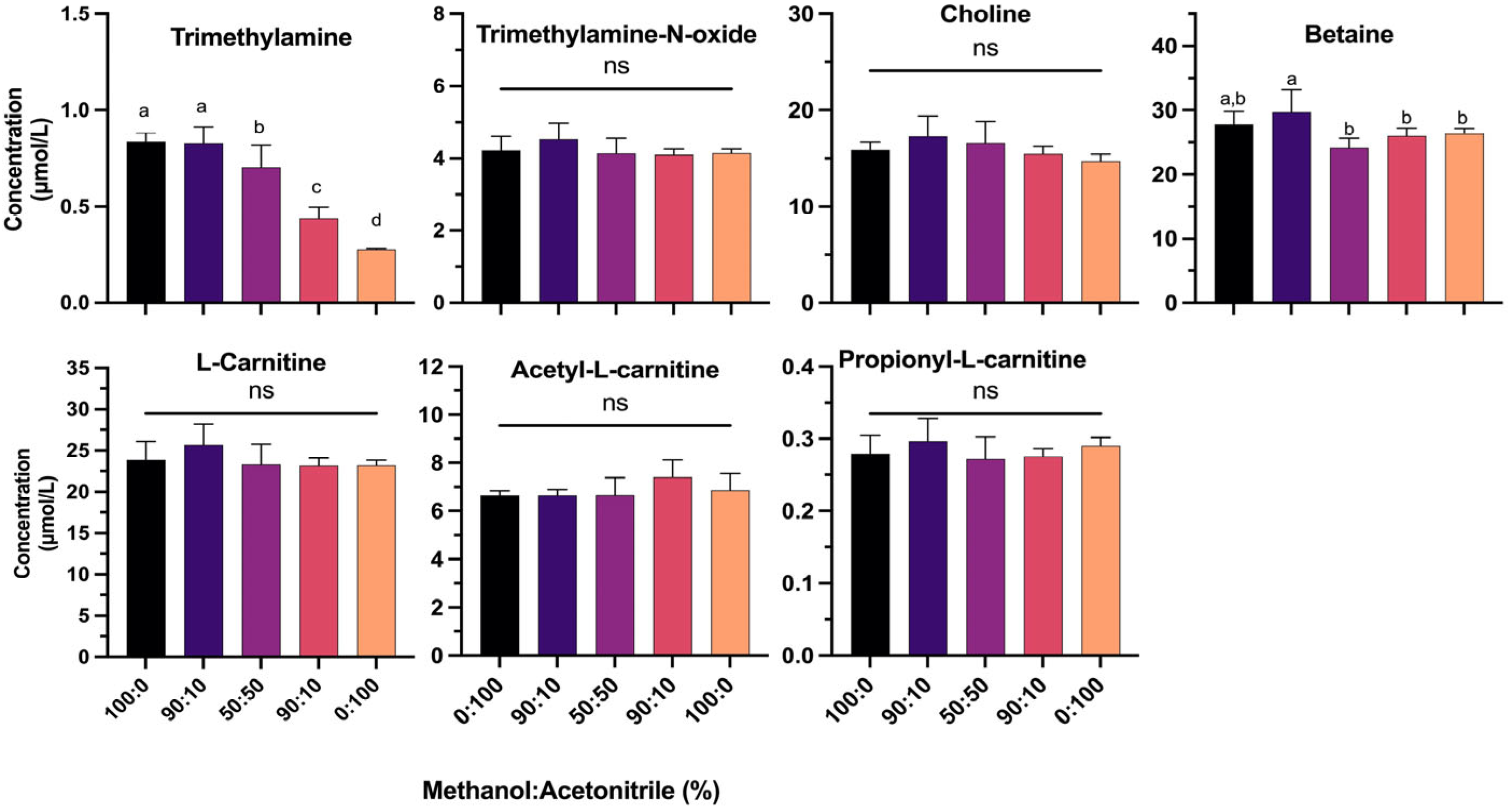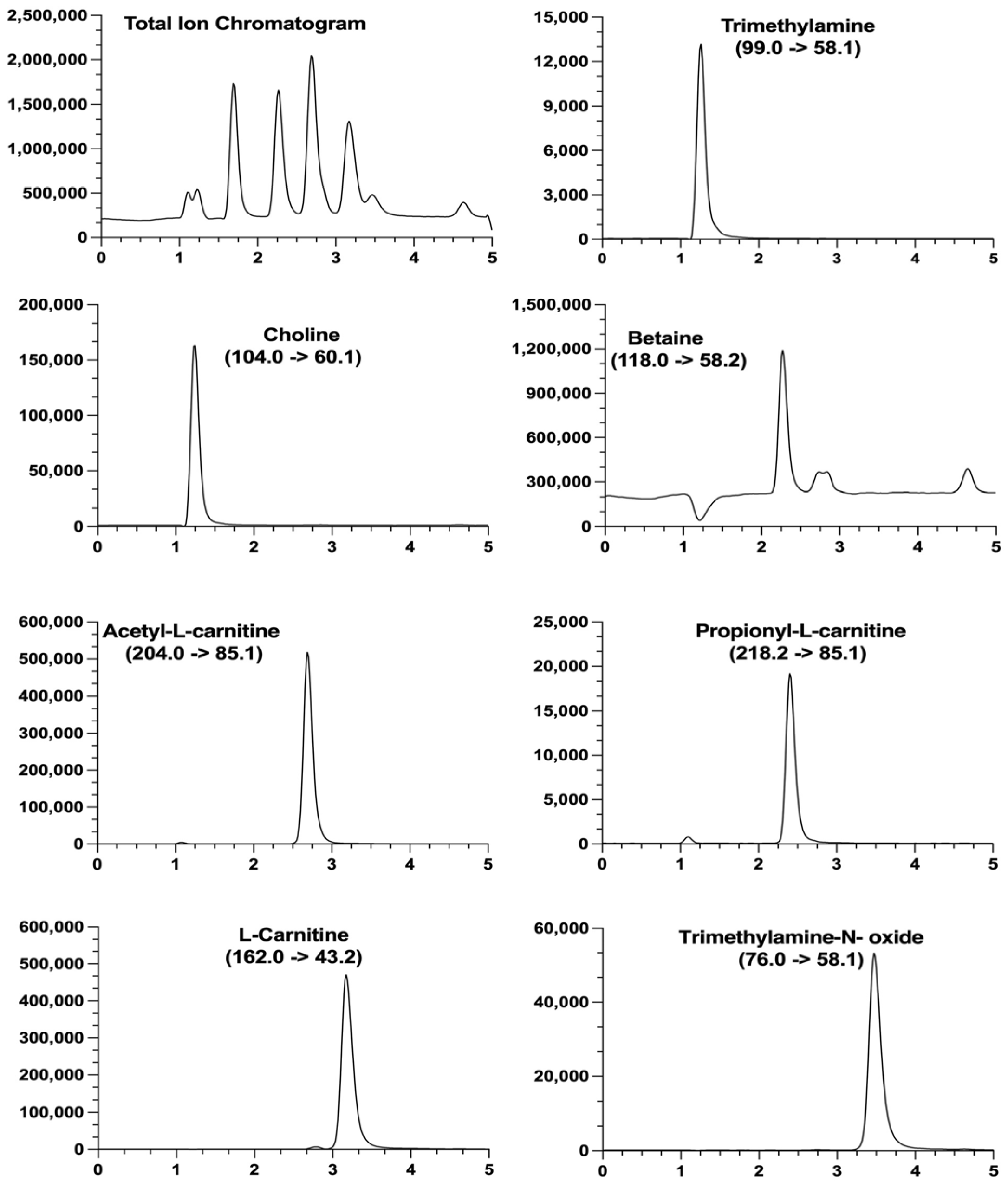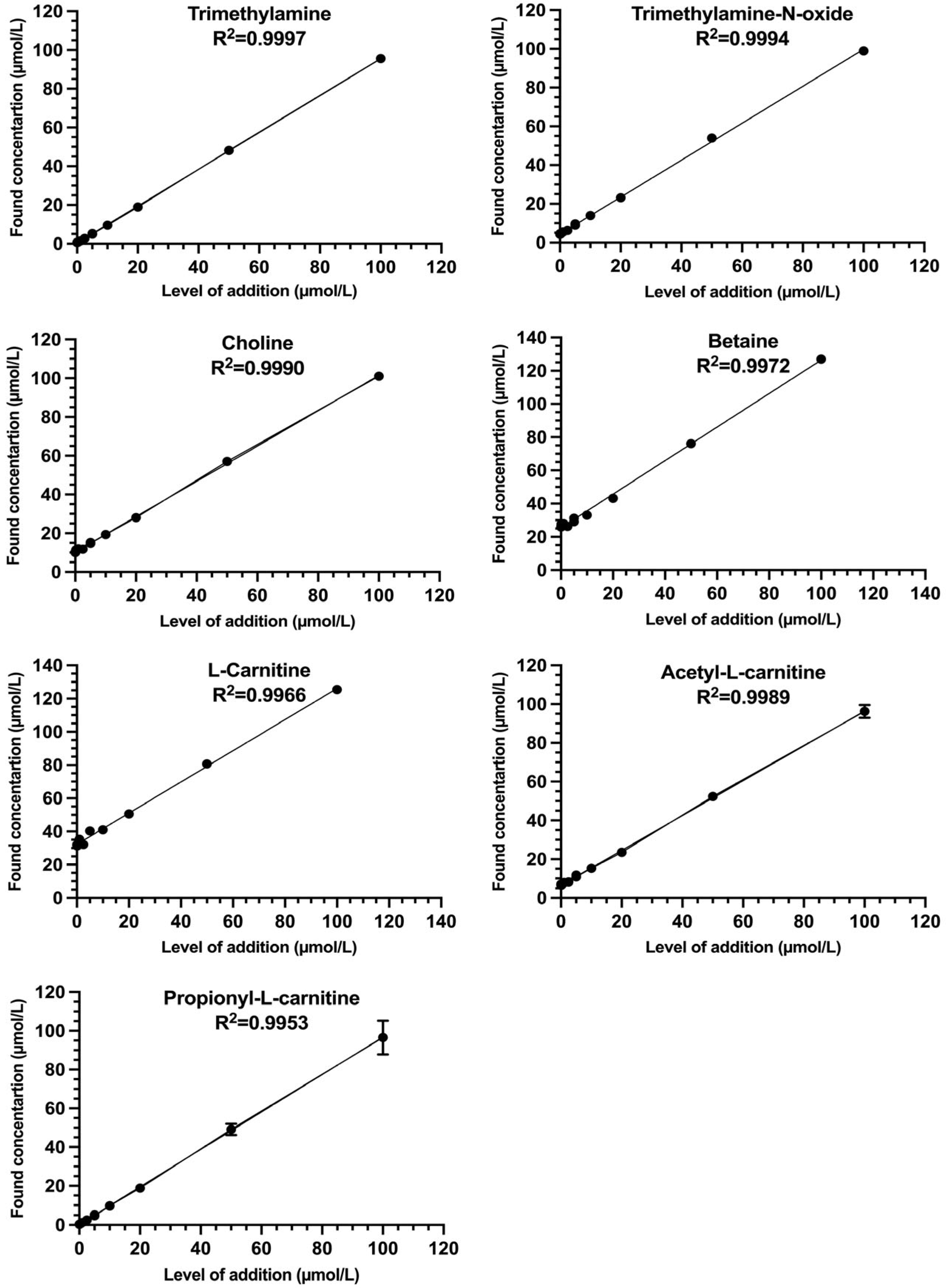Development and Application of a UPLC–MRM–MS Method for Quantifying Trimethylamine, Trimethylamine-N-Oxide, and Related Metabolites in Individuals with and Without Metabolic Syndrome
Abstract
1. Introduction
2. Materials and Methods
2.1. Reagents and Solutions
2.2. Optimization of Chromatographic Conditions
2.3. Optimization of Extraction Conditions and Derivatization of TMA
2.4. Quality Control of Analytical Method
2.5. Method Application on Clinical Plasma Samples
2.6. Calculations and Statistics
3. Results
3.1. Extraction and Derivatization
3.2. Optimized Chromatographic Conditions
3.3. Method Application
4. Discussion
4.1. Analytical Findings
4.2. Method Application
Author Contributions
Funding
Institutional Review Board Statement
Informed Consent Statement
Data Availability Statement
Acknowledgments
Conflicts of Interest
Abbreviations
| ACN | Acetonitrile |
| IACN | Iodoacetonitrile |
| IS | Internal Standards |
| LOD | Limit of Detection |
| LOQ | Limit of Quantification |
| R | Recovery |
| R2 | Coefficient of determination |
| SD | Standard Deviation |
| TMA | Trimethylamine |
| TMAO | Trimethylamine-N-oxide |
| UPLC–MRM–MS | Ultra Performance Liquid Chromatography–Multiple Reaction Monitoring–Mass Spectrometry |
References
- Wang, Z.; Klipfell, E.; Bennett, B.J.; Koeth, R.; Levison, B.S.; DuGar, B.; Feldstein, A.E.; Britt, E.B.; Fu, X.; Chung, Y.-M.; et al. Gut flora metabolism of phosphatidylcholine promotes cardiovascular disease. Nature 2011, 472, 57–63. [Google Scholar] [CrossRef] [PubMed]
- Qi, J.; You, T.; Li, J.; Pan, T.; Xiang, L.; Han, Y.; Zhu, L. Circulating trimethylamine N-oxide and the risk of cardiovascular diseases: A systematic review and meta-analysis of 11 prospective cohort studies. J. Cell. Mol. Med. 2018, 22, 185–194. [Google Scholar] [CrossRef] [PubMed]
- Heianza, Y.; Ma, W.; Manson, J.E.; Rexrode, K.M.; Qi, L. Gut Microbiota Metabolites and Risk of Major Adverse Cardiovascular Disease Events and Death: A Systematic Review and Meta-Analysis of Prospective Studies. J. Am. Heart Assoc. 2017, 6, e004947. [Google Scholar] [CrossRef] [PubMed]
- Barrea, L.; Annunziata, G.; Muscogiuri, G.; Di Somma, C.; Laudisio, D.; Maisto, M.; De Alteriis, G.; Tenore, G.C.; Colao, A.; Savastano, S. Trimethylamine-N-oxide (TMAO) as Novel Potential Biomarker of Early Predictors of Metabolic Syndrome. Nutrients 2018, 10, 1971. [Google Scholar] [CrossRef]
- Wang, Z.; Tang, W.H.W.; O’Connell, T.; Garcia, E.; Jeyarajah, E.J.; Li, X.S.; Jia, X.; Weeks, T.L.; Hazen, S.L. Circulating trimethylamine N-oxide levels following fish or seafood consumption. Eur. J. Nutr. 2022, 61, 2357–2364. [Google Scholar] [CrossRef]
- Janeiro, M.H.; Ramírez, M.J.; Milagro, F.I.; Martínez, J.A.; Solas, M. Implication of Trimethylamine N-Oxide (TMAO) in Disease: Potential Biomarker or New Therapeutic Target. Nutrients 2018, 10, 1398. [Google Scholar] [CrossRef]
- Evans, M.; Dai, L.; Avesani, C.M.; Kublickiene, K.; Stenvinkel, P. The dietary source of trimethylamine N-oxide and clinical outcomes: An unexpected liaison. Clin. Kidney J. 2023, 16, 1804–1812. [Google Scholar] [CrossRef]
- Craciun, S.; Balskus, E.P. Microbial conversion of choline to trimethylamine requires a glycyl radical enzyme. Proc. Natl. Acad. Sci. USA 2012, 109, 21307–21312. [Google Scholar] [CrossRef]
- Koeth, R.A.; Levison, B.S.; Culley, M.K.; Buffa, J.A.; Wang, Z.; Gregory, J.C.; Org, E.; Wu, Y.; Li, L.; Smith, J.D.; et al. γ-Butyrobetaine Is a Proatherogenic Intermediate in Gut Microbial Metabolism of L-Carnitine to TMAO. Cell Metab. 2014, 20, 799–812. [Google Scholar] [CrossRef]
- Messenger, J.; Clark, S.; Massick, S.; Bechtel, M. A review of trimethylaminuria: (fish odor syndrome). J. Clin. Aesthet. Dermatol. 2013, 6, 45–48. [Google Scholar]
- Yu, W.B.; Xu, C.C.; Li, G.M.; Hong, W.P.; Zhou, Z.Y.; Xiao, C.X.; Zhao, Y.Q.; Cai, Y.F.; Huang, M.; Jin, J. Simultaneous determination of trimethylamine N-oxide, choline, betaine by UPLC-MS/MS in human plasma: An application in acute stroke patients. J. Pharm. Biomed. Anal. 2018, 152, 179–187. [Google Scholar] [CrossRef] [PubMed]
- Zhao, X.Q.; Zeisel, S.H.; Zhang, S.C. Rapid LC-MRM-MS assay for simultaneous quantification of choline, betaine, trimethylamine, trimethylamine N-oxide, and creatinine in human plasma and urine. Electrophoresis 2015, 36, 2207–2214. [Google Scholar] [CrossRef] [PubMed]
- Wang, Z.N.; Levison, B.S.; Hazen, J.E.; Donahue, L.; Li, X.M.; Hazen, S.L. Measurement of trimethylamine-N-oxide by stable isotope dilution liquid chromatography tandem mass spectrometry. Anal. Biochem. 2014, 455, 35–40. [Google Scholar] [CrossRef]
- Hefni, M.E.; Bergstrom, M.; Lennqvist, T.; Fagerstrom, C.; Witthoft, C.M. Simultaneous quantification of trimethylamine N-oxide, trimethylamine, choline, betaine, creatinine, and propionyl-, acetyl-, and L-carnitine in clinical and food samples using HILIC-LC-MS. Anal. Bioanal. Chem. 2021, 413, 5349–5360. [Google Scholar] [CrossRef] [PubMed]
- Xu, C.; Zhang, M.; Zhang, S.; Wang, P.; Lai, C.; Meng, D.; Chen, Z.; Yi, X.; Gao, X. Simultaneous determination of choline, L-carnitine, betaine, trimethylamine, trimethylamine N-oxide, and creatinine in plasma, liver, and feces of hyperlipidemic rats by UHPLC-MS/MS. J. Chromatogr. B 2024, 1243, 124210. [Google Scholar] [CrossRef] [PubMed]
- Korytowska-Przybylska, N.; Michorowska, S.; Wyczałkowska-Tomasik, A.; Pączek, L.; Giebułtowicz, J. Development of a novel method for the simultaneous detection of trimethylamine N-oxide and creatinine in the saliva of patients with chronic kidney disease—Its utility in saliva as an alternative to blood. J. Pharm. Biomed. Anal. 2023, 234, 115519. [Google Scholar] [CrossRef]
- Cho, C.E.; Taesuwan, S.; Malysheva, O.V.; Bender, E.; Tulchinsky, N.F.; Yan, J.; Sutter, J.L.; Caudill, M.A. Trimethylamine-N-oxide (TMAO) response to animal source foods varies among healthy young men and is influenced by their gut microbiota composition: A randomized controlled trial. Mol. Nutr. Food Res. 2017, 61, 1600324. [Google Scholar] [CrossRef]
- Valdivia-Garcia, M.A.; Bi, Y.; Abaakil, K.; V Li, J. Derivatization to reduce background interferences for simultaneous quantitation of trimethylamine (TMA) and trimethylamine-N-oxide (TMAO) using liquid chromatography with tandem mass spectrometry. J. Pharm. Biomed. Anal. 2025, 252, 116480. [Google Scholar] [CrossRef]
- Rochlani, Y.; Pothineni, N.V.; Kovelamudi, S.; Mehta, J.L. Metabolic syndrome: Pathophysiology, management, and modulation by natural compounds. Ther. Adv. Cardiovasc. Dis. 2017, 11, 215–225. [Google Scholar] [CrossRef]
- McEntyre, C.J. Liquid Chromatography—Mass Spectrometry Methods for Investigating Osmolytes and Related One-Carbon Metabolites in Health and Disease. Ph.D. Thesis, University of Canterbury, Christchurch, New Zealand, 2016. [Google Scholar]
- European Medicines Agency. ICH Guideline M10 on Bioanalytical Method Validation and Study Sample Analysis; European Medicines Agency: Amsterdam, The Netherlands, 2022. [Google Scholar]
- Yang, Y.; Cruickshank, C.; Armstrong, M.; Mahaffey, S.; Reisdorph, R.; Reisdorph, N. New sample preparation approach for mass spectrometry-based profiling of plasma results in improved coverage of metabolome. J. Chromatogr. A 2013, 1300, 217–226. [Google Scholar] [CrossRef]
- Lepoittevin, M.; Blancart-Remaury, Q.; Kerforne, T.; Pellerin, L.; Hauet, T.; Thuillier, R. Comparison between 5 extractions methods in either plasma or serum to determine the optimal extraction and matrix combination for human metabolomics. Cell. Mol. Biol. Lett. 2023, 28, 43. [Google Scholar] [CrossRef]
- Wu, J.; Wiegand, R.; LoRusso, P.; Li, J. A stable isotope-labeled internal standard is essential for correcting for the interindividual variability in the recovery of lapatinib from cancer patient plasma in quantitative LC–MS/MS analysis. J. Chromatogr. B 2013, 941, 100–108. [Google Scholar] [CrossRef]
- León-Mimila, P.; Villamil-Ramírez, H.; Li, X.S.; Shih, D.M.; Hui, S.T.; Ocampo-Medina, E.; López-Contreras, B.; Morán-Ramos, S.; Olivares-Arevalo, M.; Grandini-Rosales, P.; et al. Trimethylamine N-oxide levels are associated with NASH in obese subjects with type 2 diabetes. Diabetes Metab. 2021, 47, 101183. [Google Scholar] [CrossRef]
- Gao, X.; Tian, Y.; Randell, E.; Zhou, H.; Sun, G. Unfavorable Associations Between Serum Trimethylamine N-Oxide and L-Carnitine Levels With Components of Metabolic Syndrome in the Newfoundland Population. Front. Endocrinol. 2019, 10, 168. [Google Scholar] [CrossRef]
- Mihuta, M.S.; Paul, C.; Borlea, A.; Roi, C.M.; Pescari, D.; Velea-Barta, O.-A.; Mozos, I.; Stoian, D. Connections between serum Trimethylamine N-Oxide (TMAO), a gut-derived metabolite, and vascular biomarkers evaluating arterial stiffness and subclinical atherosclerosis in children with obesity. Front. Endocrinol. 2023, 14, 1253584. [Google Scholar] [CrossRef]
- Andraos, S.; Jones, B.; Lange, K.; Clifford, S.A.; Thorstensen, E.B.; Kerr, J.A.; Wake, M.; Saffery, R.; Burgner, D.P.; O’Sullivan, J.M. Trimethylamine N-oxide (TMAO) is not Associated with Cardiometabolic Phenotypes and Inflammatory Markers in Children and Adults. Curr. Dev. Nutr. 2021, 5, nzaa179. [Google Scholar] [CrossRef]
- Liu, Y.; Dai, M. Trimethylamine N-Oxide Generated by the Gut Microbiota Is Associated with Vascular Inflammation: New Insights into Atherosclerosis. Mediat. Inflamm. 2020, 2020, 4634172. [Google Scholar] [CrossRef]
- Talenezhad, N.; Mohammadi, M.; Ramezani-Jolfaie, N.; Mozaffari-Khosravi, H.; Salehi-Abargouei, A. Effects of L-carnitine supplementation on weight loss and body composition: A systematic review and meta-analysis of 37 randomized controlled clinical trials with dose-response analysis. Clin. Nutr. ESPEN 2020, 37, 9–23. [Google Scholar] [CrossRef]
 100:0,
100:0,  90:10,
90:10,  50:50,
50:50,  10:90,
10:90,  0:100) as extraction solvents on the extractability of TMAO and related metabolites (µmol/L) from plasma (n = 5 replicates). Different letters a–d indicate significant differences, ns, not significant.
0:100) as extraction solvents on the extractability of TMAO and related metabolites (µmol/L) from plasma (n = 5 replicates). Different letters a–d indicate significant differences, ns, not significant.
 100:0,
100:0,  90:10,
90:10,  50:50,
50:50,  10:90,
10:90,  0:100) as extraction solvents on the extractability of TMAO and related metabolites (µmol/L) from plasma (n = 5 replicates). Different letters a–d indicate significant differences, ns, not significant.
0:100) as extraction solvents on the extractability of TMAO and related metabolites (µmol/L) from plasma (n = 5 replicates). Different letters a–d indicate significant differences, ns, not significant.


| Metabolite | Precursor Ion | Quantifier Ion/ Qualifier Ion | Collision Energy (eV) |
|---|---|---|---|
| Trimethylamine-acetonitrile | 99.01 | 58.1 59.1 | 29 17 |
| Trimethylamine-N-oxide | 76.01 | 58.1 59.1 | 21 13 |
| Choline | 104.01 | 60.1 45.1 | 17 25 |
| Betaine | 118.01 | 58.2 59.2 | 33 21 |
| Acetyl-L-carnitine | 204.01 | 85.1 29.2 | 21 50 |
| L-Carnitine | 162.01 | 43.2 60.2 | 33 17 |
| Propionyl-L-carnitine * | 218.2 | 85.1 29.2 | 21 49 |
| Internal standards (ISs) | |||
| Trimethylamine-acetonitrile-d9 | 108.01 | 66.2 68.2 | 33 17 |
| Trimethylamine-N-oxide-d9 | 85.01 | 66.2 68.1 | 25 13 |
| Choline-d9 | 113.01 | 69.2 45.2 | 21 25 |
| Betaine-d11 | 129.01 | 66.2 68.2 | 37 21 |
| Acetyl-L-carnitine-d3 | 204.01 | 85.1 29.3 | 21 50 |
| L-Carnitine-d3 | 165.01 | 43.2 103.1 | 41 17 |
| Metabolites | Calibration | Limits (µmol/L) | |||
|---|---|---|---|---|---|
| Slope | Intercept | R2 | LOD | LOQ | |
| TMA | 0.0591 | −0.018 | 0.9996 | 0.06 ± 0.01 | 0.18 ± 0.02 |
| TMAO | 0.0855 | 0.0003 | 0.9997 | 0.03 ± 0.02 | 0.09 ± 0.08 |
| Choline | 0.0575 | −0.0095 | 0.9999 | 0.03 ± 0.00 | 0.09 ± 0.01 |
| Betaine | 0.0769 | −0.0192 | 0.9998 | 0.05 ± 0.03 | 0.1 ± 0.06 |
| Acetyl-L-carnitine | 0.0630 | −0.0372 | 0.9991 | 0.08 ± 0.01 | 0.26 ± 0.02 |
| L-carnitine | 0.0604 | 0.0011 | 0.9999 | 0.02 ± 0.01 | 0.06 ± 0.02 |
| Propionyl-L-carnitine | 0.2505 | −0.0969 | 0.9996 | 0.08 ± 0.03 | 0.24 ± 0.01 |
| Level of Addition (µmol/L) | Average Concentration (µmol/L) | Average Recovery (% ± SD) | ||||||
|---|---|---|---|---|---|---|---|---|
| 0 | 5 | 10 | 20 | 50 | 100 | |||
| TMA | Cfound | 0.4 | 6.4 | 11.7 | 19.5 | 64.1 | 113.0 | |
| Recovery (%) | 118 | 113 | 95 | 128 | 112 | 114 ± 1 | ||
| TMAO | Cfound | 1.9 | 7.3 | 11.9 | 18.9 | 52.9 | 103.6 | |
| Recovery (%) | 105 | 99 | 85 | 101 | 101 | 95 ± 5 | ||
| Choline | Cfound | 10.6 | 15.3 | 19.7 | 29.7 | 58.2 | 104.6 | |
| Recovery (%) | 93 | 91 | 96 | 96 | 94 | 94 ± 2 | ||
| Betaine | Cfound | 41.9 | 46.4 | 51.1 | 61.2 | 93.5 | 132.3 | |
| Recovery (%) | 104 | 99 | 100 | 105 | 91 | 98 ± 5 | ||
| Acetyl-L-carnitine | Cfound | 4.8 | 9.8 | 14.9 | 21.3 | 63.4 | 113.2 | |
| Recovery (%) | 101 | 100 | 82 | 117 | 108 | 102 ± 3 | ||
| L-carnitine | Cfound | 30.6 | 35.8 | 40.9 | 51.3 | 82.9 | 128.5 | |
| Recovery (%) | 104 | 103 | 104 | 105 | 98 | 103 ± 3 | ||
| Propionyl-L-carnitine | Cfound | 0.3 | 5.3 | 9.8 | 19.3 | 51.2 | 103 | |
| Recovery (%) | 98.9 | 95.4 | 95.2 | 102 | 103 | 98 ± 8 | ||
| Variable | Healthy (n = 21) | Metabolic Syndrome (n = 12) | Unpaired t-Test |
|---|---|---|---|
| Trimethylamine | 1.6 ± 0.3 | 1.6 ± 0.3 | ns |
| Trimethylamine N-oxide * | 4.6 ± 6.3 | 9.5 ± 14.4 | 0.03 |
| Choline | 9.1 ± 1.9 | 9.4 ± 2.1 | ns |
| Betaine | 29.1 ± 6.5 | 30.2 ± 8.8 | ns |
| Acetyl-L-carnitine | 6.6 ± 2.2 | 6.8 ± 1.9 | ns |
| L-Carnitine | 30.4 ± 5.7 | 36.0 ± 6.7 | 0.0005 |
| Propionyl-L-carnitine | 0.27 ± 0.1 | 0.33 ± 0.1 | 0.02 |
Disclaimer/Publisher’s Note: The statements, opinions and data contained in all publications are solely those of the individual author(s) and contributor(s) and not of MDPI and/or the editor(s). MDPI and/or the editor(s) disclaim responsibility for any injury to people or property resulting from any ideas, methods, instructions or products referred to in the content. |
© 2025 by the authors. Licensee MDPI, Basel, Switzerland. This article is an open access article distributed under the terms and conditions of the Creative Commons Attribution (CC BY) license (https://creativecommons.org/licenses/by/4.0/).
Share and Cite
Hefni, M.E.; Witthöft, C.M. Development and Application of a UPLC–MRM–MS Method for Quantifying Trimethylamine, Trimethylamine-N-Oxide, and Related Metabolites in Individuals with and Without Metabolic Syndrome. Separations 2025, 12, 53. https://doi.org/10.3390/separations12020053
Hefni ME, Witthöft CM. Development and Application of a UPLC–MRM–MS Method for Quantifying Trimethylamine, Trimethylamine-N-Oxide, and Related Metabolites in Individuals with and Without Metabolic Syndrome. Separations. 2025; 12(2):53. https://doi.org/10.3390/separations12020053
Chicago/Turabian StyleHefni, Mohammed E., and Cornelia M. Witthöft. 2025. "Development and Application of a UPLC–MRM–MS Method for Quantifying Trimethylamine, Trimethylamine-N-Oxide, and Related Metabolites in Individuals with and Without Metabolic Syndrome" Separations 12, no. 2: 53. https://doi.org/10.3390/separations12020053
APA StyleHefni, M. E., & Witthöft, C. M. (2025). Development and Application of a UPLC–MRM–MS Method for Quantifying Trimethylamine, Trimethylamine-N-Oxide, and Related Metabolites in Individuals with and Without Metabolic Syndrome. Separations, 12(2), 53. https://doi.org/10.3390/separations12020053









